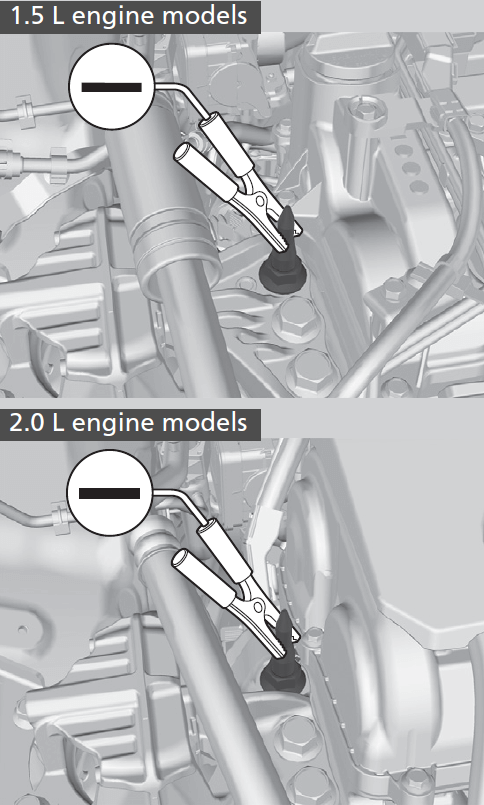Jump Starting Procedure
- WARNING
- A battery can explode if you do not follow the correct procedure, seriously injuring anyone nearby.
Keep all sparks, open flames, and smoking materials away from the battery.
- Detail
-
Securely attach the jumper cables clips so that they do not come off when the engine vibrates. Be careful not to tangle the jumper cables or allow the cable ends to touch each other while attaching or detaching the jumper cables.
Battery performance degrades in cold conditions and may prevent the engine from starting.
Turn off the power to electric devices, such as audio and lights. Turn off the engine, then open the hood.
-
- Open the cover on the positive
 terminal.
terminal. - Connect the first jumper cable to your vehicle’s battery
 terminal.
terminal. - Connect the other end of the first jumper cable to the booster battery
 terminal.
terminal.- Use a 12-volt booster battery only.
- When using an automotive battery charger to boost your 12-volt battery, select a lower charging voltage than 15-volt. Check the charger manual for the proper setting.
- Connect the second jumper cable to the booster battery
 terminal.
terminal.
- Open the cover on the positive
-

-
- Connect the other end of the second jumper cable to the stud bolt as shown. Do not connect this jumper cable to any other part.
- If your vehicle is connected to another vehicle, start the assisting vehicle’s engine and increase its rpm slightly.
- Attempt to start your vehicle’s engine. If it turns over slowly, check that the jumper cables have good metal-to-metal contact.
-

What to Do After the Engine Starts
Once your vehicle’s engine has started, remove the jumper cables in the following order.
- Disconnect the jumper cable from your vehicle’s ground.
- Disconnect the other end of the jumper cable from the booster battery
 terminal.
terminal. - Disconnect the jumper cable from your vehicle’s battery
 terminal.
terminal. - Disconnect the other end of the jumper cable from the booster battery
 terminal.
terminal.
Have your vehicle inspected by a nearby service station or a dealer.
- Detail
-
The Vehicle Stability AssistTM (VSA®) system, Vehicle Stability AssistTM (VSA®) OFF*, Adaptive Cruise Control (ACC) with Low Speed Follow*, safety support and low tire pressure/ TPMS* indicators may come on in amber along with a message in the gauge when you set the power mode to ON after reconnecting the battery.
Drive a short distance at more than 12 mph (20 km/h). Each indicator should go off. If any do not, have your vehicle checked by a dealer.
* Not available on all models
- Recommended topic(s)
